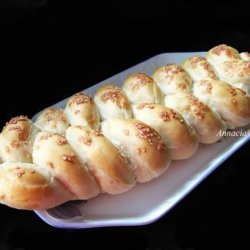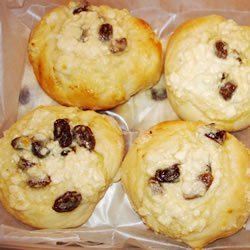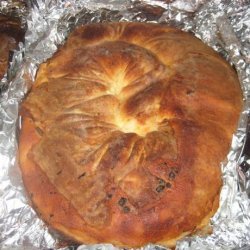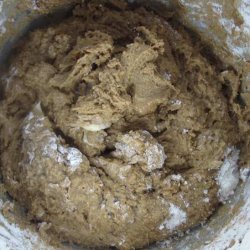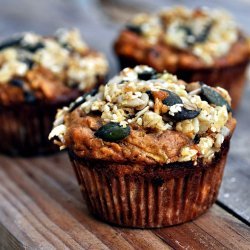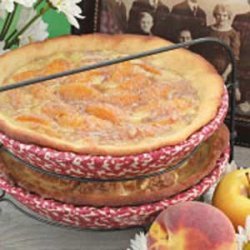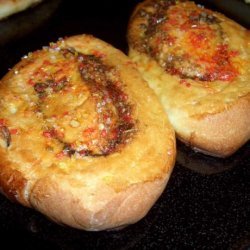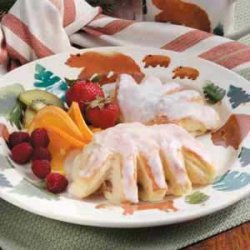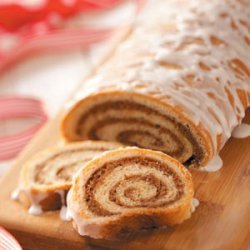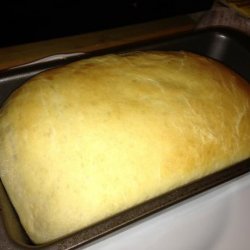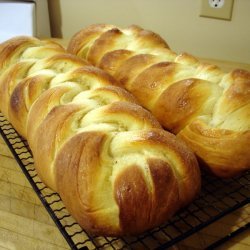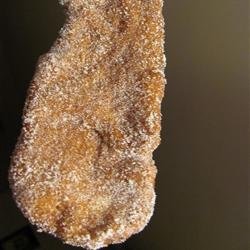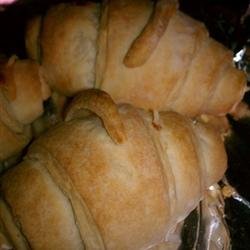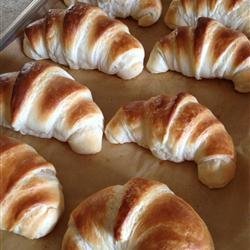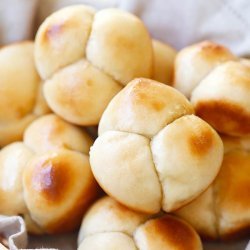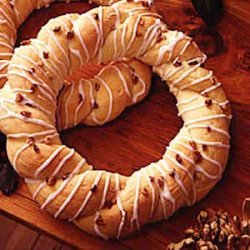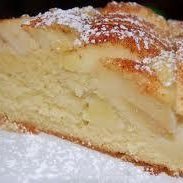Directions:
- Combine the butter and the 3 tablespoons of flour using two knives or a pastry blender.
- Place the butter mixture between two sheets of waxed paper and beat it with a rolling pin until it becomes soft and malleable. Make sure the butter stays cold though. When you're making laminated doughs such as croissant dough, puff pastry dough, or danish pastry dough it's important that the dough stays cold so the butter and the dough form distinct layers.
- Shape the block of butter into a 6- by 8-inch rectangle.
- Place the block of butter somewhere cool or back in the refrigerator while you make the dough. Don't let the butter re-harden though. If the butter re-hardens it will break through the dough when you go to roll it out. You want the butter cold but you also want it to be spreadable.
- For the dough combine the milk, yeast and sugar.
- Let sit 5 minutes or until yeast is dissolved and the surface is all foamy.
- Stir in the salt.
- Stir in the 2 7/8 cups of flour, all at once, until thoroughly combined. You should have a very soft wet dough.
- Cover the bowl of dough and place it in the refrigerator until it's chilled. If the dough is warm it might cause the butter to melt.
- Using a shaker or a sifter, generously flour your work surface. By generously I don't mean a simple dusting. You want a good substantial layer of flour. If you can see the counter top or table top underneath the flour then you need to sprinkle on more. This dough is very wet and if you don't use enough flour on your work surface the dough is going to stick. Don't add anymore flour to the dough itself because the flour you use to roll out the dough is only going to be on the surface of the dough, and it's going to be brushed away.
- Roll the dough into a 10- by 14-inch rectangle. Brush away the excess flour on the surface of the dough with a pastry brush.
- Place the block of butter on one side of the dough and fold the other side over and seal the edges.
- Turn the dough so that the fold is on the left and the part that opens is on the right (like the way a book opens).
- Roll the dough into a 9- by 17-inch rectangle. Be sure to check that it's not sticking to the table. When you you roll out the dough you want to use smooth even strokes and make sure you don't roll over the edge of the dough. If you do you'll crush the layers you're trying to make.
- Use a pastry brush to brush away ALL excess flour off the surface of the dough. This step is important because if you don't it will keep the dough from forming the layers properly.
- Fold 1/3 of the dough on to itself.
- Brush away the flour.
- Fold the other third of the dough on top of that so that the dough resembles a folded business letter. Be sure to keep the edges and corners lined up. This is what's called a turn . A turn gets its name because each time you roll out the dough you have to turn it a quarter turn so the position of the dough is always the same each time you roll it out.
- Roll out the dough and fold the dough in thirds as you did before.
- At this point you should wrap the dough up and refrigerate it for 45 minutes to an hour.
- Repeat the rolling and folding in thirds like a business letter two more times. Refrigerate the dough for an hour between each turn. Before rolling out the dough each time make sure you always position the dough so that the top flap has the fold on the left and the part that opens on the right. After the 4th turn the dough needs to be refrigerated for at least 3 hours or overnight if it's more convenient.
- Roll the dough into a 10- by 20-inch rectangle. Be sure the corners are square.
- Cut the dough into eight squares by cutting it half lengthwise and then cutting each half into 4 squares. A pizza cutter is a great tool for this job.
- Cut each square into two triangles.
- Take one of the triangles and stretch it until the two short sides are as long as the long side ( the hypotenuse in case you've forgotten your geometry).
- Roll up the triangle and curve the ends in slightly to form a crescent shape.
- Repeat with the rest of the triangles of dough.
- Place the croissants at least 2 inches apart on baking sheets that have been lightly sprayed with cooking spray or covered with parchment paper.
- Cover the croissants with towels and place somewhere where it's not too warm. You don't want the butter in them to become soft remember.
- Let croissants rise until they're nearly doubled in size. This may take a few hours. Be patient. I've let them rise for as long as 5 to 6 hours. After about 2 hours the surface of the croissants may start to dry out. If this happens cover them with a damp paper towel and then put another towel on top of that.
- Combine the egg and the teaspoon of water.
- Brush a light coating of egg wash on each croissant. If the croissants are exceptionally puffy you'll need to be extra gentle when you brush on the eggwash. Another option is to put the eggwash in a spray bottle and spray the eggwash on the croissants.
- Bake the croissants in a preheated 425° F oven for 12 to 15 minutes until they're golden brown.
Nutrition Facts
| Amount Per 1 Serving | |||
| Calories | 618.15 Kcal (2588 kJ) | ||
| Calories from fat | 360.51 Kcal | ||
| % Daily Value* | |||
| Total Fat | 40.06g | 62% | |
|---|---|---|---|
| Cholesterol | 129.98mg | 43% | |
| Sodium | 622.14mg | 26% | |
| Potassium | 214.74mg | 5% | |
| Total Carbs | 53.97g | 18% | |
| Sugars | 3.37g | 13% | |
| Dietary Fiber | 3.19g | 13% | |
| Protein | 11.24g | 22% | |
| Vitamin A | 0.5mg | 16% | |
| Iron | 0.9mg | 5% | |
| Calcium | 89.2mg | 9% | |
| Amount Per 100 g | |||
| Calories | 348.34 Kcal (1458 kJ) | ||
| Calories from fat | 203.15 Kcal | ||
| % Daily Value* | |||
| Total Fat | 22.57g | 62% | |
|---|---|---|---|
| Cholesterol | 73.25mg | 43% | |
| Sodium | 350.59mg | 26% | |
| Potassium | 121.01mg | 5% | |
| Total Carbs | 30.41g | 18% | |
| Sugars | 1.9g | 13% | |
| Dietary Fiber | 1.8g | 13% | |
| Protein | 6.33g | 22% | |
| Vitamin A | 0.3mg | 16% | |
| Iron | 0.5mg | 5% | |
| Calcium | 50.3mg | 9% | |
* Percent Daily Values are based on a 2000 calorie diet. Your daily values may be higher or lower depending on your calorie needs.
Find out how many calories should you eat.
Get Your Recipe of Health!
Follow RecipeOfHealth on Facebook!


